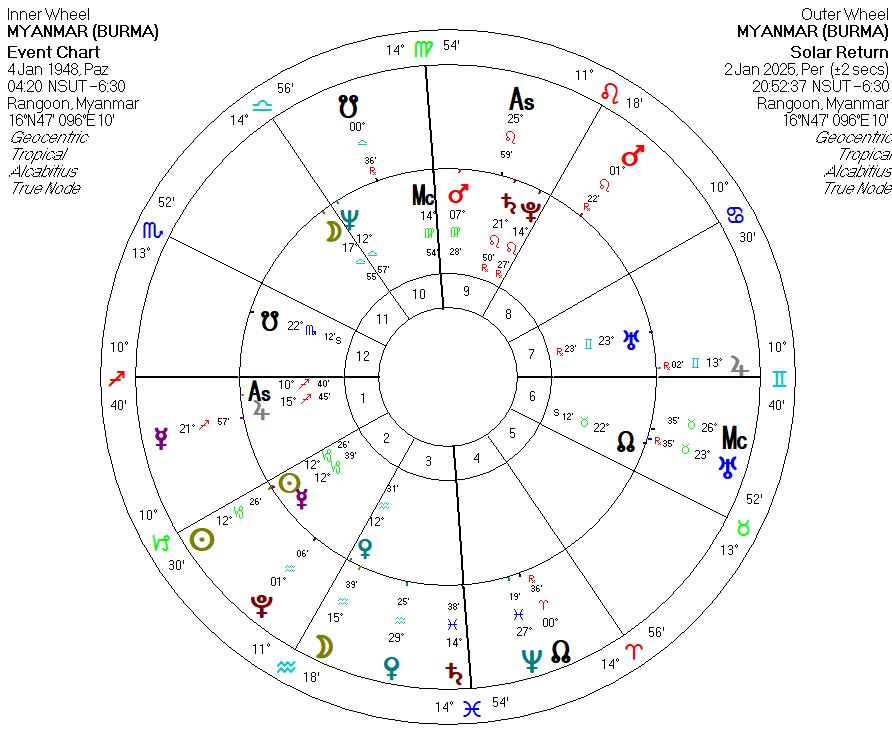The world witnessed two earthquakes in Myanmar, measuring 7.7 and 6.4 in magnitude, occurring just 12 minutes apart and approximately 100 kilometers from the capital, Naypyidaw.
With this brief Solar Return assessment, I’d like to share some key indicators I frequently encounter in astrological studies of earthquakes and natural disasters.
Myanmar (Burma)’s natal chart is recorded in Nicholas Campion’s collection as January 4, 1948, at 04:20 AM (NSUT -6:30) in Rangoon, Myanmar.

In the country’s current Solar Return chart, Uranus is prominently positioned at the Midheaven. Uranus, known for its sudden and unexpected nature, is often linked to shocking events, disruptions, and earthquakes. Neptune, symbolizing subterranean liquids and magma layers, is also closely associated with earthquakes and appears in the 8th house of the Solar Return chart.
When earthquakes reach a catastrophic level, we often see the 8th and 11th houses emphasized. The 8th house represents disasters and death, while the 11th house is the 8th house from the 4th—thus reflecting disasters originating from the land or earth. Notably, the 11th house is intercepted by Gemini, and its ruler Mercury is applying a square aspect to Neptune in the 8th house—another significant indicator.
Among all the houses, the 6th house frequently appears in earthquake charts. Why? Because it is the 3rd house (movement) from the 4th house (land), symbolizing the movement of the earth—a perfect description of an earthquake.
In this chart, the 6th house is ruled by Saturn, and its dispositor (Pisces) forms a square to Jupiter, a dynamic we recognize from the 20-year Jupiter-Saturn cycle. Indeed, Ptolemy once associated Saturn with earthquakes, leaving us with this enduring insight. While various explanations exist, there’s compelling symbolic evidence connecting Saturn to mountains, and thus to seismic activity. (Saturn = Mountains = Seismic Pressure)
✅ For further reading on this symbolic link between Saturn and earthquakes, you can refer to:
- “Astrological Earthquake Prediction” by David Williams (Astrological Journal, 1981)
- Ptolemy’s Tetrabiblos, Book II – especially the chapters on natural phenomena.
Another alarming aspect is that Pluto, at 1° in the 6th house, is in a partile opposition with retrograde Mars, the exalted ruler of the 6th house (Capricorn). This adds another layer of intensity.
Yet, not every earthquake, regardless of magnitude, turns into a disaster. Planets do not act with intention. They do not make decisions on our behalf. The choices are ours—if we fail to construct earthquake-resistant buildings or to design our cities in harmony with nature, the consequences will inevitably be catastrophic.
Thus, Saturn, Pluto, or Uranus are not inherently disaster-bringers, but they symbolize collective indicators. If a planetary configuration involves outer planets, it often implies that the event, though locally initiated, may have broader implications and affect nearby regions or even the global stage.

In the second image, we observe the comparison of the national chart and the Solar Return. Pay close attention to the 6th, 8th, and 11th houses.
In the 6th house, transiting Uranus is present. Its ruler, Venus, sits at the anaretic 29° of Aquarius—a critical and unstable degree. Venus’s dispositor Saturn is conjunct the country’s IC, intensifying the theme of disruption from the land.
Additionally, the exalted ruler of the 6th house, the Moon, acts as a trigger by interacting with both the natal Venus and Pluto. The Moon also rules the 8th house—bringing a recurring symbolism into focus.

In the third image, we examine the Solar Return’s astrocartography lines. With Uranus at the Midheaven in the chart, we naturally find its MC line emphasized on the map.
Interestingly, Venus’s Descendant line also crosses the region in question. Since this is a disaster-related event, the Venus line—especially where it cuts across Thailand—suggests that other populated areas might also be affected.

In the fourth image, we dive deeper with azimuthal or angled astrocartography to examine more subtle planetary lines from the Solar Return chart.
We see that both the IC line of Neptune and its 150° Ascendant line pass within 70 km (44 miles) of Naypyidaw. This reminds us that quincunx (150°) aspects, although often overlooked, are powerful indicators of accidents, blind spots, and even earthquakes.
Truthfully, to study earthquakes and other natural events astrologically, a multilayered analysis is essential—including Aries ingresses, eclipses, lunations, critical degrees, Moon’s lunar standstills, declinations, and more.
Additionally, this year marks the Solar Maximum, making it crucial to monitor how solar activity impacts Earth’s geomagnetic field and, in turn, seismic behavior.
While this article is limited to a brief Solar Return-based evaluation, I also aimed to summarize the most frequent indicators I’ve observed in earthquake astrology.
Wishing safety and healing to all those affected.
Kenan Yasin Bölükbaşı
ASA Dip. ISAR Cap, mAPAI, OPA member, CIA Eu Representative


Liam_P
Very informative. I appreciate the effort.
Deneysel Astroloji
thank you